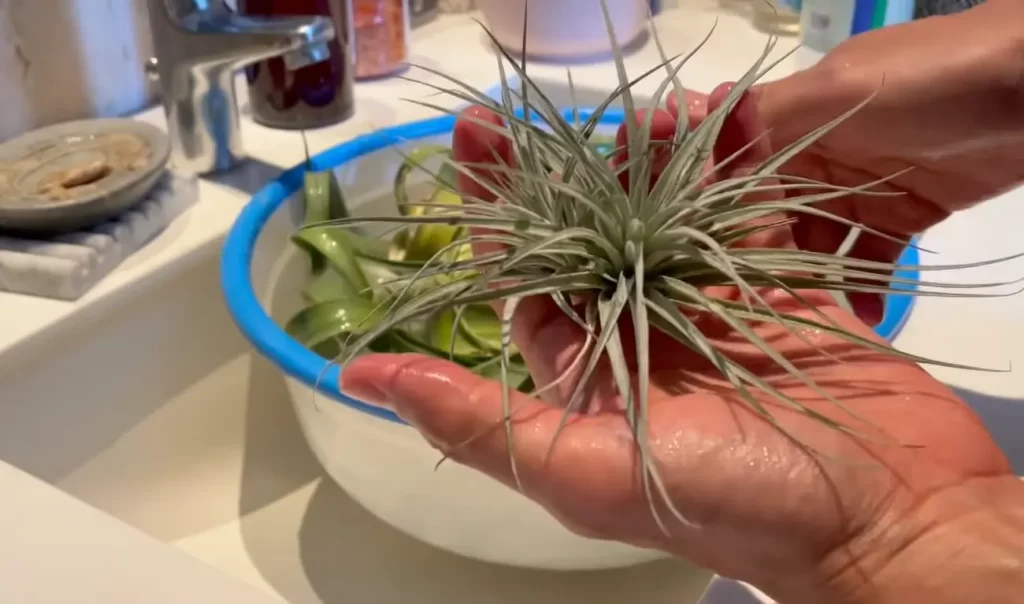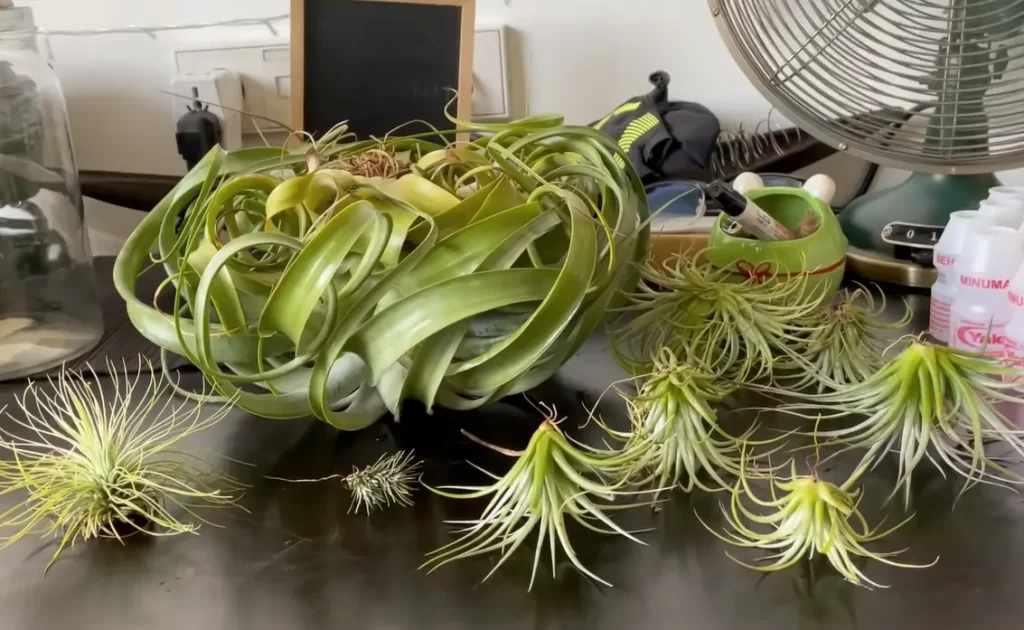How Air Plants Grow Without Soil: All You Need To Know
Air plants are fascinating plants that have captured the attention of many plant enthusiasts. Unlike most plants, these plants are unique because they do not require soil to grow. Instead, they have adapted to absorb water and nutrients from the air and other organic matter. Now a question arises how do air plants grow without soil?
Air plants grow without soil by absorbing water and nutrients through their specialized leaves from the air, rainwater, and decaying organic matter. They have evolved to adapt to different environments and grow in trees, rocks, and other surfaces.
This article will explore the anatomy of air plants, how they absorb water and nutrients, the environmental requirements for their growth, and how to care for them. We will also discuss the various uses and benefits of air plants and why they are a great option for those looking for a low-maintenance, sustainable plant.
The Characteristics Of An Air Plant
Air plants are unique plants adapted to grow without soil and absorb water and nutrients through their specialized leaves. Some common characteristics of air plants include:

- Epiphytic Nature: Air plants grow attached to other plants, trees, rocks, or other surfaces rather than in soil.
- Specialized Leaves: These plants have specially adapted leaves to absorb water and nutrients from the air rather than through their roots. These leaves are covered in scales, trichomes, or other structures that help to capture moisture and nutrients.
- Diverse Shapes And Sizes: There are over 650 air plants, ranging from tiny plants just a few centimeters in size to larger species that grow up to a meter in length. They come in various shapes, from rosettes to trailing vines, and are green, silver, red, or other colors.
- Low Maintenance: Air plants are relatively easy to care for and require minimal maintenance. They do not need to be planted in soil and grow in various containers or other surfaces.
- Environmental Adaptability: These plants are adapted to a wide range of environmental conditions, including humidity, temperature, and light. This makes them suitable for a variety of indoor and outdoor environments.
- Decorative Use: Air plants are popular for their unique appearance and are often used for decorative purposes. They are displayed in terrariums, on driftwood or other decorative objects, or as a part of living walls or green roofs.
How Do Air Plants Grow In The Absence Of Soil?
Air plants have evolved to grow without soil and absorb water and nutrients through their specialized leaves. This adaptation allows them to thrive in various environments, including trees, rocks, and other surfaces. While soil is typically medium in which plants grow and absorb nutrients, air plants have adapted to absorb nutrients directly from the air, rainwater, and other decaying organic matter they come into contact with.
Air plants have developed specialized structures on their leaves, such as scales, trichomes, and other adaptations that allow them to capture moisture and nutrients. These structures help the plant retain moisture and nutrients from the environment, allowing it to thrive even in scarce water and nutrients.
Because air plants don’t rely on soil for their growth, they are incredibly adaptable and grow in various ways. They can be mounted on different surfaces, such as wood, rocks, or shells, or placed in containers without soil. This makes them popular for indoor gardens, terrariums, and other decorative displays. However, if you want to know: Does copper kill air plants, you should research about that.
The Different Parts Of An Air Plant, And How Do They Function
Air plants, like most plants, have several different parts that perform specific functions. Here is a breakdown of the different parts of an air plant and their functions:
- Leaves: The leaves of an air plant are its most important feature. They are responsible for absorbing moisture and nutrients from the air and other sources. The leaves of air plants come in a wide range of shapes and sizes, and some have specialized structures, such as scales or trichomes, that help them to absorb and retain moisture.
- Stem: The stem of an air plant provides support and structure for the plant. In some species, the stem may also absorb water and nutrients.
- Roots: While air plants have roots, they are primarily used to anchor the plant to its substrate rather than absorb nutrients. The roots of air plants are often very thin and delicate, and they do not penetrate deeply into the substrate.
- Flowers: Air plants produce small, colorful flowers that can be a food source for pollinators. The flowers are scented, which attracts insects that aid in pollination.
- Pups: Air plants produce small offshoots called “pups.” These pups grow from the base of the plant and can be separated from the parent plant and grown independently.
How Air Plants Obtain Water And Nutrients Without Soil
Air plants obtain water and nutrients without soil by absorbing them through their specialized leaves. They have evolved to capture moisture and nutrients from the air, rainwater, and other decaying organic matter they come into contact with.
These plants have a unique system of trichomes, tiny scales or hairs on the leaves, that allow them to absorb water and nutrients through their leaves. The trichomes capture moisture from the air and any other sources that come in contact with the plant and then absorb the necessary nutrients.
They also absorb nutrients through their roots, a secondary nutrition source. Air plant roots are primarily used for anchoring the plant to its substrate rather than absorbing nutrients.
To obtain water, air plants require regular misting or soaking in water. They absorb moisture from the air to thrive in humid environments.
The Ideal Conditions For Air Plant Growth
Air plants are versatile plants that grow in various conditions, but some ideal conditions will help air plants thrive. Here are some of the ideal conditions for air plant growth:
- Lighting: Air plants require bright, indirect light. They can tolerate direct sunlight in the morning or late afternoon, but direct sunlight for extended periods can cause their leaves to burn. A good rule of thumb is to place air plants near a window that receives bright, filtered light for most of the day.
- Temperature: Air plants prefer warm temperatures between 60-90°F (15-32°C). They can tolerate lower temperatures for short periods, but prolonged exposure to temperatures below 50°F (10°C) can cause damage.
- Humidity: Air plants require a humid environment to thrive. Ideally, the humidity should be between 50-70%. Misting or soaking air plants helps maintain humidity levels.
- Water: Air plants require regular watering to stay healthy. They can be misted daily or soaked in water for a few hours every 1-2 weeks. Let air plants dry completely before returning to their display area to prevent rot.
- Air Circulation: Good air circulation is important for air plant growth. Stagnant air cause moisture to build up on the leaves, leading to rot. Air plants should be placed in an area with good air circulation to prevent this.
- Fertilizer: Air plants require very little fertilizer but benefit from occasional fertilization with a diluted liquid fertilizer, especially during the growing season.
The Uses And Benefits of Air Plants
Looking for a unique and versatile plant to enhance your indoor space? Look no further than air plants, which offer aesthetic appeal and a range of benefits for your health and well-being. Air plants have several uses and benefits, including:

- Ornamental Use: Air plants are visually stunning and can be used as decorative items in homes, offices, and other indoor spaces. They come in different shapes, sizes, and colors, making them versatile ornamental plants.
- Low Maintenance: Air plants are low maintenance and do not require soil, making them an easy-to-care-for indoor plant option. They can grow without a lot of attention and care.
- Air Purification: Air plants purify the air in their surroundings. They remove pollutants and toxins from the air, improving indoor air quality.
- Stress Reduction: Plants, in general, are known to reduce stress and anxiety levels. Air plants are no exception; their presence creates a calming and relaxing environment.
- Educational Use: Air plants are great for kids and adults alike. They offer a unique opportunity to learn about plant biology, ecosystems, and the environment.
- Creative Use: These plants are used in various DIY projects, such as terrariums, hanging displays, and living walls. They are versatile and fun plant species to work with in creative projects.
Final Words
Air plants are fascinating and unique and adapted to grow without soil. Their ability to absorb water and nutrients through their leaves and roots allows them to thrive in various environments.
By understanding the specific needs of air plants and providing them with the right care, you can enjoy their beauty and benefits in your home or office. Whether you use them for their ornamental value, air purification, stress reduction, or creative projects, air plants are a great addition to any indoor space.
After reading this article, we hope you understand how air plants grow without soil. So, give them a try and experience the wonder of these remarkable plants.
